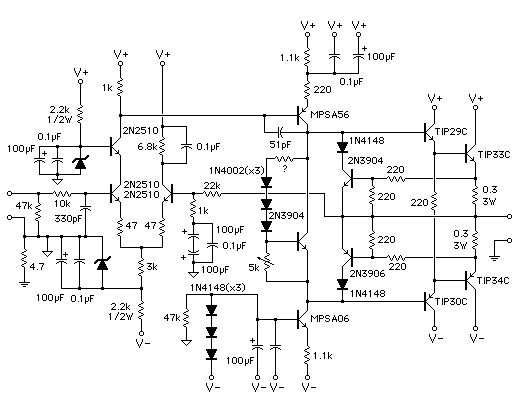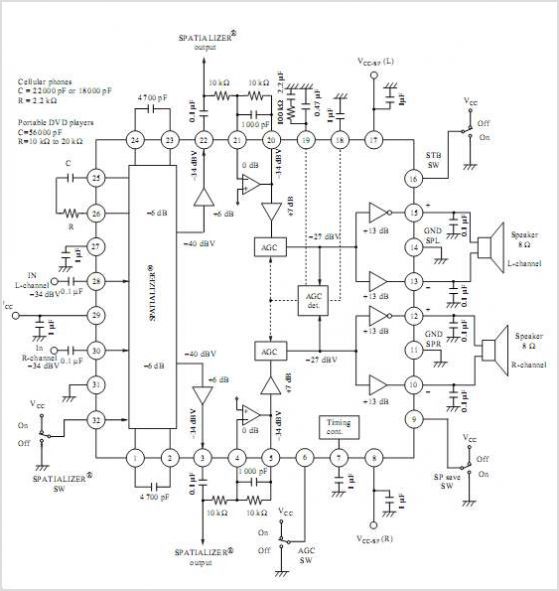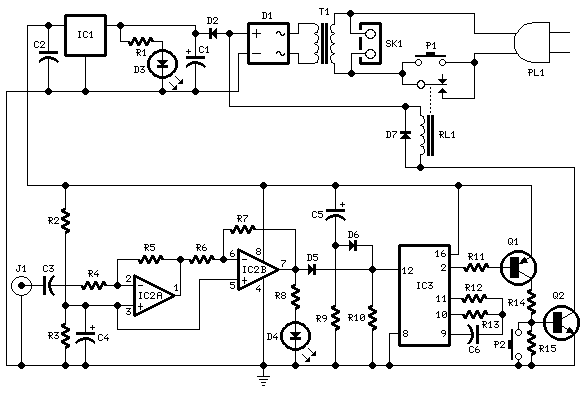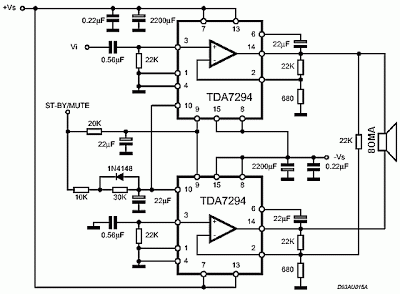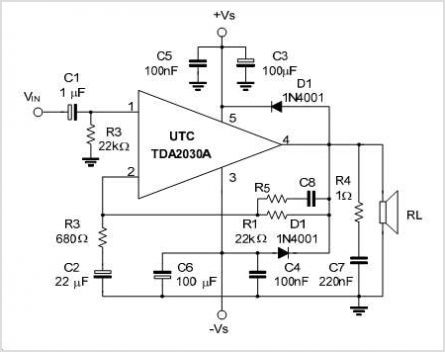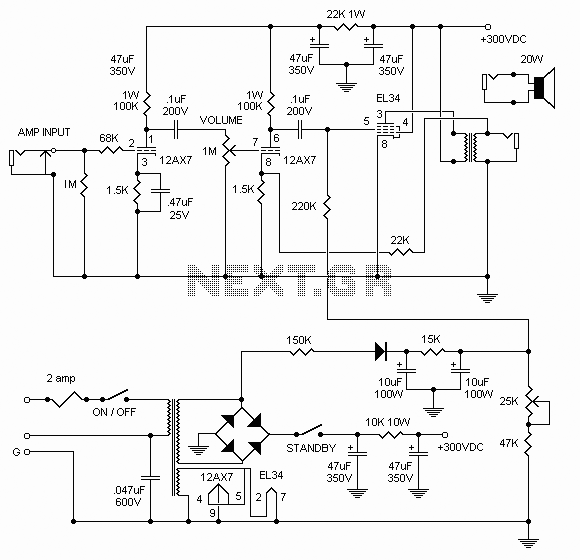
Guitar Amplifier
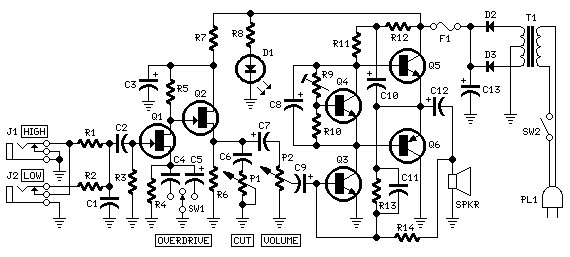
The aim of this design was to reproduce a Combo amplifier of the type very common in the sixties and the seventies of the past century. It is well suited as a guitar amplifier but it will do a good job with any kind of electronic musical instrument or microphone. 5W power output was a common feature of these widespread devices due to the general adoption of a class A single-tube output stage (see the Vox AC-4 model). Furthermore, nowadays we can do without the old-fashioned Vib-Trem feature frequently included in those designs. More: The present circuit can deliver 10W of output power when driving an 8 Ohm load, or about 18W @ 4 Ohm. It also features a two-FET preamplifier, two inputs with different sensitivity, a treble-cut control and an optional switch allowing overdrive or power.
The described Combo amplifier circuit is designed to replicate the vintage sound characteristics and functionality prevalent in the 1960s and 1970s. It employs a Class A single-tube output stage, which is a hallmark of traditional amplifiers, particularly noted in the Vox AC-4 model. This output stage is capable of delivering a power output of 10W when connected to an 8 Ohm speaker load and can reach approximately 18W with a 4 Ohm load, providing sufficient power for both practice and performance settings.
The amplifier features a two-FET preamplifier stage that enhances the signal from various electronic musical instruments or microphones, ensuring a broad frequency response and low noise operation. The inclusion of two inputs with different sensitivity levels allows for versatility in connecting different types of instruments, accommodating both high-output electric guitars and lower-output acoustic instruments or microphones.
Additionally, the circuit incorporates a treble-cut control, which enables users to tailor the high-frequency response of the amplifier to suit their tonal preferences. This feature is particularly useful for dialing in a warmer sound, which is often desired in musical applications. An optional switch is also provided to facilitate overdrive or power boost functionality, allowing the user to achieve a more saturated and dynamic sound when desired.
Overall, this Combo amplifier design balances vintage aesthetics and modern enhancements, making it a suitable choice for musicians seeking both nostalgic tones and contemporary usability. The elimination of outdated features, such as the Vib-Trem effect, streamlines the design while maintaining essential functionalities, ensuring that it meets the needs of today's musicians.The aim of this design was to reproduce a Combo amplifier of the type very common in the `sixties and the `seventies of the past century. It is well suited as a guitar amplifier but it will do a good job with any kind of electronic musical instrument or microphone.
5W power output was a common feature of these widespread devices due to the general adoption of a class A single-tube output stage (see the Vox AC-4 model). Furthermore, nowadays we can do without the old-fashioned Vib-Trem feature frequently included in those designs.
The present circuit can deliver 10W of output power when driving an 8 Ohm load, or about 18W @ 4 Ohm. It also features a two-FET preamplifier, two inputs with different sensitivity, a treble-cut control and an optional switch allowing overdrive or powerf
🔗 External reference
The described Combo amplifier circuit is designed to replicate the vintage sound characteristics and functionality prevalent in the 1960s and 1970s. It employs a Class A single-tube output stage, which is a hallmark of traditional amplifiers, particularly noted in the Vox AC-4 model. This output stage is capable of delivering a power output of 10W when connected to an 8 Ohm speaker load and can reach approximately 18W with a 4 Ohm load, providing sufficient power for both practice and performance settings.
The amplifier features a two-FET preamplifier stage that enhances the signal from various electronic musical instruments or microphones, ensuring a broad frequency response and low noise operation. The inclusion of two inputs with different sensitivity levels allows for versatility in connecting different types of instruments, accommodating both high-output electric guitars and lower-output acoustic instruments or microphones.
Additionally, the circuit incorporates a treble-cut control, which enables users to tailor the high-frequency response of the amplifier to suit their tonal preferences. This feature is particularly useful for dialing in a warmer sound, which is often desired in musical applications. An optional switch is also provided to facilitate overdrive or power boost functionality, allowing the user to achieve a more saturated and dynamic sound when desired.
Overall, this Combo amplifier design balances vintage aesthetics and modern enhancements, making it a suitable choice for musicians seeking both nostalgic tones and contemporary usability. The elimination of outdated features, such as the Vib-Trem effect, streamlines the design while maintaining essential functionalities, ensuring that it meets the needs of today's musicians.The aim of this design was to reproduce a Combo amplifier of the type very common in the `sixties and the `seventies of the past century. It is well suited as a guitar amplifier but it will do a good job with any kind of electronic musical instrument or microphone.
5W power output was a common feature of these widespread devices due to the general adoption of a class A single-tube output stage (see the Vox AC-4 model). Furthermore, nowadays we can do without the old-fashioned Vib-Trem feature frequently included in those designs.
The present circuit can deliver 10W of output power when driving an 8 Ohm load, or about 18W @ 4 Ohm. It also features a two-FET preamplifier, two inputs with different sensitivity, a treble-cut control and an optional switch allowing overdrive or powerf
🔗 External reference
Warning: include(partials/cookie-banner.php): Failed to open stream: Permission denied in /var/www/html/nextgr/view-circuit.php on line 713
Warning: include(): Failed opening 'partials/cookie-banner.php' for inclusion (include_path='.:/usr/share/php') in /var/www/html/nextgr/view-circuit.php on line 713
